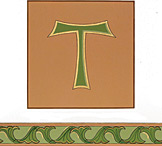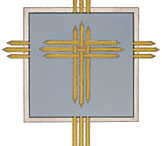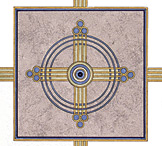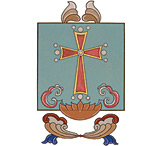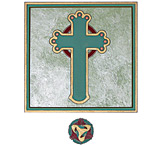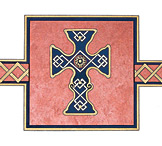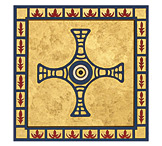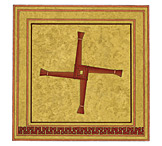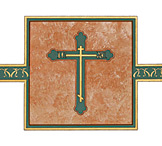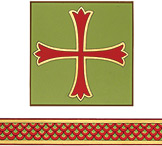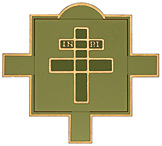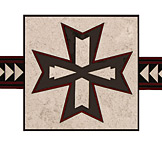Crosses of Spes Unica
By Scot Erin Briggs
This is a story of symbols.
Once the new academic building, the longtime dream of more than 600 donors, stood gleaming in the fall light, it needed a name. We needed a symbol, a concise way to refer to this new campus destination, but the name should also reflect both the tradition that is its foundation and the future that it represents. It was, in short, a tall order.
Once suggested, however, the designation was accepted unanimously. It would be called Spes Unica Hall, borrowed from the motto of the Congregations of the Holy Cross and the College: “Ave Crux, Spes Unica,” which translates from Latin to “Hail O Cross, our only hope.”
At this point in the story, serendipity steps in. Sister Agnes Anne Roberts, CSC, who is Saint Mary’s director of facilities planning, happened upon the artwork of PennyLea Mackie while visiting Saint Alphonsus Regional Medical Center in Boise, Idaho, a hospital founded by the Sisters of the Holy Cross. The art she saw was a series of crosses commissioned for the hospital. Sister Agnes Anne returned to Saint Mary’s inspired.
A series of paintings was commissioned for Spes Unica. Again, the sine qua non was that the art should represent both the tradition and the future of Saint Mary’s. The result was a blending of symbols: the cross as it has been depicted within different cultures. The paintings include Indian, Chinese, and Native American representations, among others. The paintings are bordered with complementary symbols from each culture. The finished art now hangs outside Spes Unica classrooms.
Symbols have an interesting history. The word “symbol” comes from the ancient Greek practice of breaking an object into pieces so that the owners of those pieces could prove their identity at a future date by showing that the pieces fit together. Think of those “best friend” pendants, shaped like a heart (or the symbol for a heart, more properly), where each friend wears half.
This idea of a symbol as a piece of whole, lends depth to the idea that the meaning of symbols can change and that they can be combined to create a new meaning.
“It’s a wonderful playground for me to immerse myself in, these symbols,” says the artist, PennyLea Mackie, who calls herself “a lover of God.” For Mackie, the cross represents “that point where the seen and the unseen meet.” The borders “bring it into the material world, onto a more material plane without subtracting from that transcendence. The borders let you feel comfortable enough with the image to immerse yourself in what it symbolizes.”
“The cross is an ambiguous symbol,” says Professor Phyllis Kaminski, chair of the Religious Studies Department. “A symbol of death,” she says, noting that in the time that Jesus lived, execution by crucifixion was common, “becomes a symbol of salvation.”
Sister Rose Anne Schultz, vice president for mission, says this symbol of salvation leads students back to the College’s mission. “As you pass the cross, you remember that you are loved, that Jesus loves you very much. It’s a sign of that love. Anytime you know you’re loved, there’s an invitation to express that love yourself. How are you willing to give of yourself?”
“These crosses become a symbol of our catholicity with a small ‘c’ as well as our Catholicism. So it becomes a kind of outreach,” says Professor Kaminski. “We are using a traditional symbol to point us in a future direction.”
Tau Cross
The Tau Cross is an ancient symbol named after the Greek letter it resembles. Saint Francis of Assisi often told his brother friars that their religious habit was in the same shape as the Tau cross. He exhorted them to go out into the world, wearing this cross like an incarnation of Christ. St. Francis used the Tau Cross as his signature, and it continues to be cherished by Franciscans worldwide.
Triparted Cross
The Triparted Cross represents the Trinity. It is comprised of three vertical and three horizontal arms, all of equal length and arranged in such a way that their intersections resemble basket weaving, each piece integrated with the others in a woven center. The resulting twelve arm ends can also correspond to the twelve Apostles.
Sun Cross
The Sun Cross is one of the oldest and most widespread of spiritual symbols, appearing in Asian, American, European, and Indian religious art. Composed of an equal armed cross within a circle, the four divisions within the circle represent the four seasons, marked by the solstices. In Christian iconography, it most closely resembles the monstrance with the Eucharist displayed in the center.
Chinese Cross on Lotus Flower
The mounting of the cross on the lotus flower is a common iconographic motif to be seen on Indian and Chinese artifacts dating from the fourth century. This is evidence of an early Christian presence on both continents. In Buddhist symbolism the lotus flower represents purity and beauty. Ancient Vedic teachers considered the world to be a giant lotus with India, Iran, Central Asia and China seen as its four petals with the Himalayas as its center. The cross at its center symbolizes the rule of Christ over the entire world.
Latin Cross
The cross on which Jesus died became a later symbol of the Christian faith, replacing the lamb, fish, alpha/omega, and phoenix as emblems. The Latin Cross has become associated with Roman Catholicism and is often shown in different shapes and sizes, in many different styles. When the cross has a figure of our Lord painted or sculpted on it, it is called a crucifix.
Tullylease Cross
Many freestanding upright crosses, depicting a labyrinth of various patterns, were erected by Irish monks in Celtic regions of Ireland. The Tullylease Cross is an 8th century artifact found in the ruins of the monastery founded by St. Berichter in County Cork. The cross consists of a labyrinth of key patterns. The labyrinth is an ancient symbol found around the world. In the Christian sense, it represents the journey of life, or pilgrimage, toward God.
St. Cuthbert’s Cross
St. Cuthbert, originally a Celtic Christian, was a medieval Anglo-Saxon monk and Bishop of Lindisfarne in the Kingdom of Northumbria. He is called “Wonder-worker of England” due to numerous and extraordinary miracles celebrated in his name. St. Cuthbert’s Cross is a replica of the cross with which he was buried. The cross is seen mainly on heraldic regalia and similar ceremonial dress. It has four equal-length arms to fit the shape of shields in coats-of-arms.
St. Brighid’s Cross
The St. Brighid’s Cross is a very delicate looking cross usually made from plaited straw. According to legend, the Irish St. Brighid was comforting a dying pagan chieftain and picked up some rushes from the floor to weave into a simple cross as she told him the story of Jesus’ death and resurrection. After hearing the story, the man asked for forgiveness of his sins, converted to Christianity, and then died.
Eastern Orthodox Cross
The Eastern Orthodox Cross is made up of three bars crossing a vertical pole. The top bar represents the plaque bearing Pontius Pilate’s inscription. The lower slanting beam represents the footrest, since the Eastern Church believed that Christ was crucified with his feet side by side, and not placed one on top of the other. Its angled position suggests the Cross of St. Andrew, the apostle who introduced Christianity into Russia.
Patonce Cross
The Patonce Cross is any form of cross which has expanded ends with each arm terminating in floriated points like the Fleur-de-lis Cross. In heraldry, the three petals represent faith, wisdom and chivalry. The four arms spread these to the four corners of the world. As a Christian Cross, the three petals represent the Trinity and the total twelve petals represent the Apostles.
Titulus Cross
When crucifixions were commonplace it was customary to place a board at the top of the cross listing the crimes of the crucified person. The board on which the proclamation was written was called titulus cruces. If a Christian cross has an inscription, it is most often INRI, since this represents the wording on Christ’s cross.
Native American Cross
This cross image dates back to the late 19th century, southwestern United States territories. The chevrons and the arrows pay homage to the four cardinal directions while pointing to the center position of the heart. Many followers of Native American spirituality do not regard their spiritual beliefs and practices as a “religion” in the way in which many Christians do. Their beliefs and practices form an integral and seamless part of their very being.


